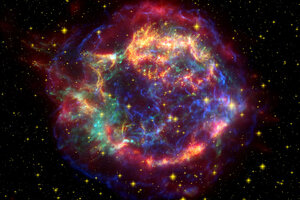Astronomers spot last gasps of dying star
A study in Nature Physics paints the most complete picture yet of the first six to ten hours of a supernova some 160 million light-years from Earth.

An image provided by NASA is a false-color picture showing the many sides of the supernova remnant Cassiopeia A. Astronomers say they have observed a supernova in the Pegasus constellation within the first three to 10 hours of exploding.
AP/NASA
What ends with a bang might start with a sputter, according to astronomers.
A new paper published Monday in Nature paints the most complete picture yet of a giant star's end-of-life process. Captured a mere six to ten hours after the start of a violent supernova, images of lingering stellar material surrounding the star reveal hints of what the supergiant was doing during its final year of life.
While the core collapse that triggers this kind of supernova is common, the trick is catching one in the act. Stars can burn for billions of years, and scientists never know when one is about to blow. The paper estimates that statistically speaking, not one of the 100 to 400 billion stars in our Milky Way galaxy is likely to be within one year of going supernova.
But detection is getting better, thanks to new technologies such as the intermediate Palomar Transient Factory (iPTF). "Until several years ago, catching a supernova even a week after explosion was regarded as early," lead author Ofer Yaron said in an interview with ResearchGate.
Thanks to the iPTF’s camera, which scans a tenth of the sky every night looking for new flashes, scientists routinely catch supernovae in their first days. Glimpses of the initial minutes have also been seen, according to Space.com, but never in as much detail as this observation.
The feat was an international effort. On October 6, 2013, an automated computer program noticed a twinkle of light in galaxy NCG 7610, one that hadn’t been there the day before. The game was afoot.
The computer relayed images from the Palomar Observatory to the Weizmann Institute of Science in Israel, where it was still early in the day. The supernova confirmed, scientists around the world leapt into action.
California Institute of Technology researcher Dan Perely made four detailed observations six to ten hours after the supernova, with astronomers in Spain and Australia following up in the days and months that followed, The Washington Post reports.
All together, the scientists succeeded in capturing the earliest images over such a wide range of spectra, from radio waves to X-rays.
The new information helps astronomers better understand how and why massive stars explode as supernovae, which the paper calls “one of the outstanding open questions in astrophysics.”
Stars are essentially fusion machines, squeezing atoms together to make heavier elements at intense pressures and temperatures. For the vast majority of a star’s life, it fuses hydrogen atoms into helium, but as the core gets denser it starts to combine successively heavier elements.
The process speeds up towards the every end, finishing with the production of iron, which halts fusion in its tracks, triggering a core collapse at a significant percentage of the speed of light and flinging stellar shrapnel outwards in an unimaginable explosion.
This explosive debris erases all observable traces of the star’s behavior immediately before the collapse, unless you can catch it right in the act, as Dr. Yaron’s team has.
The early spectra taken in Hawaii indicate that “the progenitor star is engulfed with a spherical shell of circum-stellar material (CSM), a disk of matter surrounding the star,” according to Yaron. In other words, an unusual halo of star-stuff surrounds the dying star.
This conclusion lends further support to an emerging theory that elderly stars cough up stellar material during the final stages of life. Yaron says that the strongest interpretation of the data reveals the star expelled more than 300 Earths' worth of matter in the few hundred days prior to its explosion. That material came to settle in a disk stretching up to tens of billions of miles away from the star.
Their observations do not rule out other explanations for the disk, such as a steady, weaker wind that blew material away from the star more slowly, over a longer period of time.
Either way, the discovery promises to improve scientists’ understanding of the supernova process, and perhaps even allow astronomers to identify about-to-blow stars.
"It's as if the star 'knows' its life is ending soon, and puffing material at an enhanced rate during its final breaths," Yaron told Space.com. "Think of a volcano or geyser bubbling before an eruption."
To aid in the quest for ever more timely supernovae discoveries, an iPTF upgrade is imminent. This year the project will transition to the Zwicky Transient Factory, which will be able to scan the entire sky each day .
Israel's currently unfunded UltraSat space telescope would yield even more frequent scans.
Yaron suggests this find is just the beginning of the story. As he told Space.com, "with the help of new sky surveys coming up in the very near future, we expect to significantly increase the number of supernova events for which we are able to obtain early observations within hours and maybe minutes from explosion."

